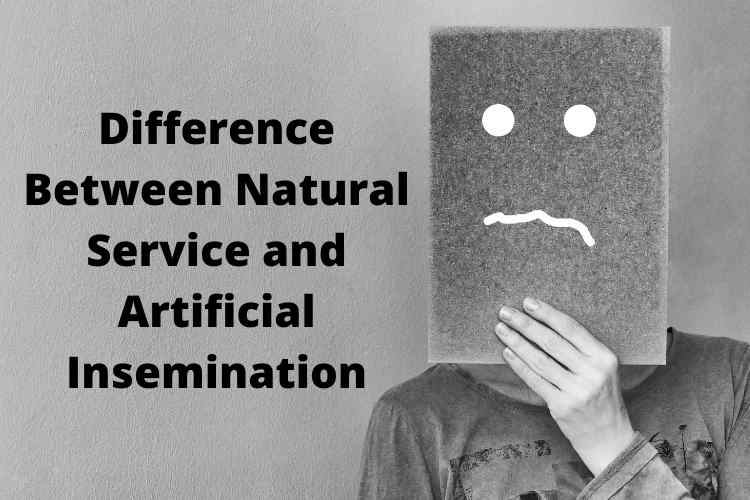Some producers will contemplate utilizing artificial insemination (AI) in their breeding herd as the breeding season approaches; others will not due to the additional time, labour, and administration necessary in an AI programme, as well as the perceived expenses of applying AI. In this blog we are going to tell you the Difference Between Natural Service and Artificial Insemination, so read this blog carefully to get the complete information. Artificial insemination isn’t only a new way of getting females to become pregnant. Instead, it is a strong instrument that is mostly used to enhance cattle. But there is another natural service that is opted for. So, let’s discuss the difference between these Artificial Insemination and Natural Service.
What is Natural Service?
As humans, we have been heavily reliant on natural resources for our well-being and survival from the dawn of time. These ecological services play a critical role in the development and maintenance of human prosperity. Almost everything we do is reliant on natural ecosystems including wetlands, forests, grasslands, and mountains. The interplay between live creatures and nature creates these natural ecosystems. Human existence would be impossible without natural services.
Natural service (NS) is one of two commonly utilized methods for calving cows and is a significant aspect of farm reproductive management. The dairy industry’s economic survival is dependent on reproductive efficiency. For the most part, most cattle breeders and cow-calf producers continue to use NS. It’s a natural breeding method in which the bull and the cow are permitted to mate while they’re in heat naturally. This is the process of cattle mating by natural means. For cow reproduction, natural breeding is more cost-effective than artificial insemination.
What is Artificial Insemination?
Artificial insemination (AI) and estrous synchronization, which are the most essential and widespread breeding procedures employed in the dairy sector today, are frequently used by cow breeders. AI is an ART Assisted Reproductive Technology that collects sperm cells from a man and deposits them directly into a female’s reproductive tract. Artificial insemination (A.I.) has the major benefit of increasing the utility of excellent sire to an extraordinary degree. It makes inherited sires for milk and butterfat output available to all dairymen within a certain area. Previously, only a few could benefit from good bulls.
AI is employed in creatures ranging from a little honey bee to a massive elephant, as well as humans. In affluent countries, AI has had a significant influence on cattle development initiatives. It is the most popular choice among cattle producers, and it frequently leads to enhanced reproductive performance, calf performance, and herd genetics. When compared to a natural breeding program, the expenditures involved with adopting AI are greater. Although the AI approach has been employed as a tool for controlled breeding in many nations, there are expenditures associated with it that are not incurred with natural breeding, such as labor, medications, semen, and technician fees. It’s a way of artificially impregnating females using instruments, which necessitates specialized equipment, well-trained operators, and more time.
Difference between natural service and artificial insemination in cattle
Natural service and artificial insemination (AI) are the two main methods of breeding cattle, with clear differences in process, genetics, efficiency, cost, and disease control.
| Aspect | Natural Service | Artificial Insemination (AI) |
| Method | Bull mates naturally with cow | Semen collected, manually placed in cow |
| Genetic control | Limited; uses farm’s bulls | High; can select superior sires |
| Efficiency | Lower (one bull per herd) | Higher (many cows from one bull’s semen) |
| Disease risk | Higher (direct contact, STD risk) | Lower if managed hygienically |
| Labor/skill needed | Low (less technical skill) | High (requires skill and timing) |
| Cost | Ongoing cost to keep bulls; space | Lower long term; no need to keep bulls |
| Safety | Bulls may be aggressive, risky | Safer; no need for bulls in herd |
| Genetic diversity | More random genetics | Can risk reduced diversity if few sires |
| Flexibility | Less flexible (bulls needed onsite) | Very flexible (semen can be shipped/stored) |
| Pregnancy rate | Typically higher per breeding | Sometimes lower, depends on management |
| Time/labor | Quick and less management intensive | More planning required |
Detailed Explanation
- Natural Service: The bull mates directly with cows. This requires physically managing the bull, which can be costly and risky. There is less control over genetics, and direct contact can lead to disease spread and injuries. Fertility rates are typically high, but genetic progress is slow.
- Artificial Insemination: Semen from a selected bull is collected and inserted into the cow’s reproductive tract using tools and expertise. AI allows precise genetic selection, rapid herd improvement, and broad distribution of superior genetics. It reduces disease risk and cost by removing the need for bulls on farm, but success relies on careful timing and technical skill.
FAQs
What is the main difference between natural service and artificial insemination?
Natural service involves direct mating between male and female animals, while artificial insemination uses collected semen inserted into the female’s reproductive tract without natural mating.
Which method is more effective — natural service or artificial insemination?
Artificial insemination is more effective for improving genetics, controlling breeding, and reducing disease transmission.
What are the advantages of natural service?
Natural service is simpler, requires less equipment, and is cost-effective for small-scale breeders.
Why is artificial insemination preferred in modern livestock farming?
It allows better genetic selection, prevents the spread of infections, and enables the use of superior sires globally.
Can both methods be used together?
Yes, farmers sometimes combine both methods to optimize breeding efficiency and maintain genetic diversity.
Conclusion:
These are the major differences between Artificial Insemination and Natural Service. We hope that the difference is clear to you.

